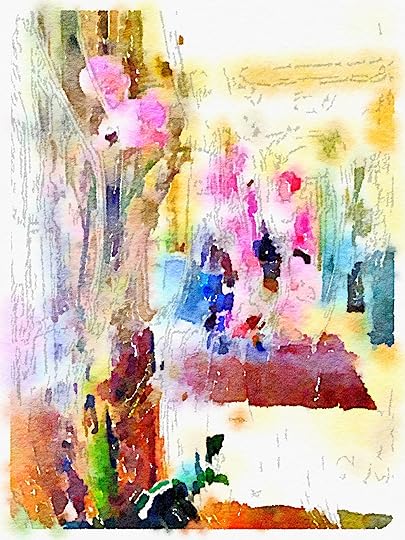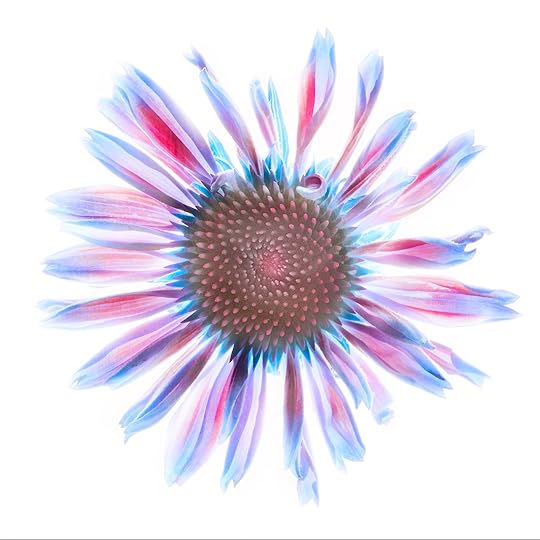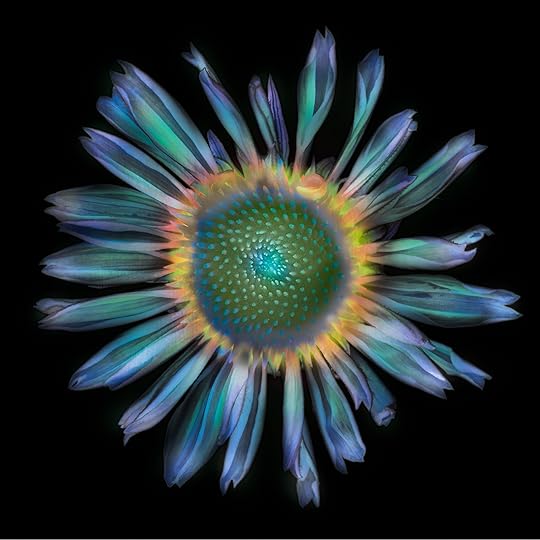Harold Davis's Blog, page 159
April 27, 2015
Rain on Variegated Bamboo
Last week there was a much-needed overnight rain. Early in the morning I prowled the neighborhood with my camera and tripod, and as the showers were winding down photographed these water drops on a leaf of a variegated bamboo.

Rain on Variegated Bamboo © Harold Davis
You can learn more about water drop photography—in the spirit of “shaken, not stirred” these are natural, not artificial water drops—in my Focal Press book Photographing Waterdrops.

April 24, 2015
Old and New: A Tale of Two Kirk BH-3 Ball Heads
My Kirk BH-3 tripod ball head has served me well on four continents on the trail, in the studio, in mountains, deserts, and along the rugged Pacific host, from the barrios of Havana to the souks of Morocco and the Boulevards of Paris. So one day recently, when my BH-3 reported to duty with a definite kink in the retaining plate bracket and knob, it was with sadness that I replaced him in favor of a brand spanking new model. Time goes by, and since change is incremental one doesn’t see the markings until there is a new one for comparison.

Old and New – Kirk BH-3 Ball Heads © Harold Davis
As I’ve noted, technique is not at the apex of the Maslowvian triangle of photographic needs (vision is), but technique is still my craft, and I am very fond of the tools that help me practice my craft, and want to give my old BH-3 ball head the most honorable send off possible, as it retires and becomes a paper weight and conversation piece rather than an ongoing part of my day-to-day photographic life.

Kirk BH-3 Ball Head – Facing Retirement © Harold Davis

April 23, 2015
Hierarchy of Photographic Needs
The American psychologist Abraham Maslow famously wrote of a hierarchy of needs, with basic physiologic needs at the bottom of the hierarchy and self-actualization at the apex of the triangle of needs. Love, connection, and cathexis come somewhere in the middle of the Maslowvian hierarchy. A recent blog story of mine about a photo of a red onion seems to have brought up some issues related to a photographic hierarchy of needs, based on both what I wrote originally and on some comments.

Old-Fashioned Rose © Harold Davis
Many folks liked the story about the onion and everyday objects: “Your onion photograph, together with your comments, was an extraordinarily clear re-enforcement lesson.” One reader wanted to know why their personal inner world, or vision, should interest anyone else (you can read the full question and my lengthy response in the comments to the story). A comment on my Facebook timeline for this post suggests that “finding subject matter is no problem. It’s everywhere. Shooting it well, well….”
Which leads me back around to the hierarchy of photographic needs. The basic “physiologic” need is to be able to make a capture. Because without a capture you don’t have a photograph.
So many people starting photography assume that if they get a “better” camera they will make better photos because their captures are better, with more megapixels, or whatever.
So what happens when you get the more expensive gear and you discover that your photos are still not what you are looking for (or perhaps even seem banal)? The next category up the hierarchy of photographic needs is technique. If you are the kind of person who is not very self-reflexive you might assume that if only you could learn to be a better photographer technically, your images would get more interesting.
The disappointment here is that photos can be technically impeccable and still ultimately banal. So up the hierarchy some of us go one more time, with the realization that it is important to bring one’s own unique vision into the work.
Ultimately, any photo worth its salt is both about something external—this essentially comes in the definition of the photographic process—and a personal way of seeing that bespeaks the holistic person behind the vision. As I wrote in the comments to the Red Onion story, this necessitates a balance: “Work that is too preciously about oneself is ultimately shallow—Cindy Sherman comes to mind. On the other hand, work that is not self-revelatory to some degree is unlikely to have much real emotional power, and it is important to truly live and to imbue one’s art with one’s life.”
Ultimately, photographic gear is necessary, but very far from sufficient. Photographic technique is only the framework for exhibiting vision, and not the vision itself. Vision must come from a well-lived life—even when the image is of an object as ordinary as a red onion, or as apparently simple on the surface as the Old-Fashioned Rose photo shown above.

April 22, 2015
Flora Exhibit at Photo Oakland
Welcome the summer with PHOTO’s beautiful and curious new collection of plant imagery! The exhibition will run May 14 – June 20, 2015. I’ll have a few pieces of my botanical art in this exhibition. Please consider joining me at the artist’s reception on Thursday, May 21, 2015, 6PM – 8PM. Here’s more information about the exhibition.

Papaver Somniferum and Friends © Harold Davis
Exhibition: May 14 – June 20, 2015
Reception: Thursday, May 21, 2015, 6PM – 8PM
PHOTO Fine Art Photography
473 25th Street, Oakland, CA 94612
info@photogalleryoakland.com
For further details: www.photogalleryoakland.com/exhibition/flora-show/

Tulip Pano © Harold Davis

April 21, 2015
Photograph Italy with Harold Davis this Autumn
I am offering a unique opportunity to join me and a very exclusive group as we photograph Italy this autumn (the dates are October 28 – November 11, 2015). If you are tired of being part of the photographic herd, then this is the trip for you! The group size is strictly limited to six participants. We only have two spots left!
 We will be photographing in Cinque Terre, Naples, the island of Capri, and in Positano and the Amalfi coast. Accommodations, transportation, and many meals are included. I will be working with a top-flight local Italian licensed tour guide with an art history background to make sure that we have the best experience possible. Please see www.digitalfieldguide.com/learning/workshops-events/italy for full details.
We will be photographing in Cinque Terre, Naples, the island of Capri, and in Positano and the Amalfi coast. Accommodations, transportation, and many meals are included. I will be working with a top-flight local Italian licensed tour guide with an art history background to make sure that we have the best experience possible. Please see www.digitalfieldguide.com/learning/workshops-events/italy for full details.
As a workshop leader, my goal is to is to facilitate a community of photographers, have fun photographing in interesting and exciting places, share some technical information, and—most importantly—encourage each participant’s unique and individual creative expression. As one of my workshop participants has put it, “Harold is genuine, generous, and gracious. He has a world of knowledge and expertise that he loves to share. His wonderful books show his monumental talents and skill set, and his workshops show the depth of his connecting with others in a very real and personal way.”
Please join me in Italy this autumn. I look forward to working with you one-on-one in exciting locations to realize your photography dreams and goals.

April 20, 2015
Hyper-Reality
It is certainly possible to capture a world in a grain of sand, or a water drop. Perhaps less obviously, there is also a chance of rendering the apparently mundane and seeing worlds, clouds, and maybe mountains within it. The technique here is to make the subject over-the-top clear, so the detail in the photograph seems hyper real. I find myself baffled by students who seek help finding subject matter, as the everyday world around us is always full of source material that is grist for the artistic mill.

Hyper Reality © Harold Davis

April 19, 2015
Flowers at a Restaurant
I photographed these orchids through translucent etched glass at the handsome Murray Circle Restaurant at the Cavallo Point Inn, part of Fort Baker in Sausalito, California. The location is right across the Golden Gate Bridge from San Francisco. If you are interested, you can read my review of the restaurant on Trip Advisor (opens in a new window).

Flowers at a Restaurant © Harold Davis
Photographed using my iPhone camera app, and processed in Waterlogue.

April 17, 2015
Palace of King Charles V in the Alhambra
The Alhambra in Granada, Spain was first a fortress, and then a fairy-tale palace built as a citadel on a hill by the Moorish rulers of Andalusia. Conquered by Ferdinand and Isabella at about the time Columbus sailed the to the “new” world, the place fell into neglect until it was rediscovered by the romantic movement (and the author Washington Irving) in the early 1800s. Alhambra, California is named after this place, and the genuine Alhambra in Granada is today one of the most popular tourist attractions in Spain.

Alhambra © Harold Davis
The Holy Roman Emperor Charles V was also the King of Spain, and ruled the largest empire in terms of land mass of all times. He ordered an imperial palace to be build within the footprint of the Alhambra.

Palace of Charles V © Harold Davis
The exterior of the Palace of Charles V is massive. It is fairly regular and unspectacular on the outside, and seems (unsurprisingly) quite imperial in its aesthetic. What is unusual is the curvilinear nature of the interior courtyard, shown here, putting the building (as Wikipedia puts it) in the avant-garde of its time. You can see the image of the Palace of Charles V in a larger size by clicking on it.

Creative Portfolio Weekend Workshop
We have a few spaces available in the Creative Portfolio Weekend Workshop, Saturday May 9 and Sunday May 10, 2015. Click here for information and registration.
The gist of this workshop is how to you edit work, how do you put it together into a cohesive body, and what are the mechanics of creating an effective presentation—whether it is for marketing the work, or for creating something that is unique and beautiful in-and-of itself.
This is not a printmaking workshop per se, or a workshop limited to a specific printer, or even necessarily to those making their own prints (although of course I do think this is a good idea)—so the term “portfolio” is conceived broadly to cover the both online presence, and work presented as a cohesive, printed portfolio or book. The group will be working on exercises before the workshop—so sign up to get started now!
Each workshop participant will receive a copy of the Creative Workbook that is the companion to my new book from Focal Press, Achieving Your Potential As a Photographer.
Click here for information and registration.

April 16, 2015
LAB Inversions
I am often asked about my technique for obtaining creative effects using LAB color adjustments in Photoshop. While the theory behind this set of techniques is a bit complicated, there’s nothing complex in practice about using LAB color adjustments creatively. I’ve written about these techniques both in The Photoshop Darkroom and also in The Way of the Digital Photographer.
To make your life easier if you want to experiment with creative LAB, I’ve also written a Photoshop action that you can download for free using this link (check out the included readme file for installation instructions). This action essentially presents the possible LAB channel adjustments as a palette of possibilites for you to choose from when making your creative choices, and I’ve used my own action—Photoshop’s word for a macro—to create the different creative versions of the images shown here.
For example, with the cone flower (Echinacea) shown here, last year I planted it in a pot on the porch, assuming it would essentially be an annual. Somewhat to my surprise, it has come back strongly for a second year in its pot. We water it with recycled water—such as unfinished water bottles started by the kids. The young flowers are translucent and striated, like the day-old blossom shown. As the flowers mature, the petals become opaque, and a mono-colored shade of pink magenta.

Echinacia © Harold Davis
The miracle of LAB channel inversions and adjustments leads straight to the alternative, colorful versions you see below:

Inversion on white © Harold Davis
I plan to print these images as a quadtych, with the four images arranged in a sequence, pairing the original version on white with the Inversion on White, and the two black versions together.

Echinacia Inversion © Harold Davis

Inversion in Blue © Harold Davis





